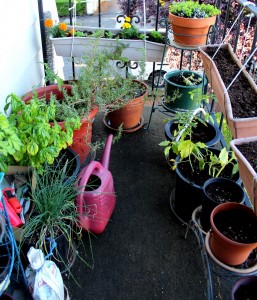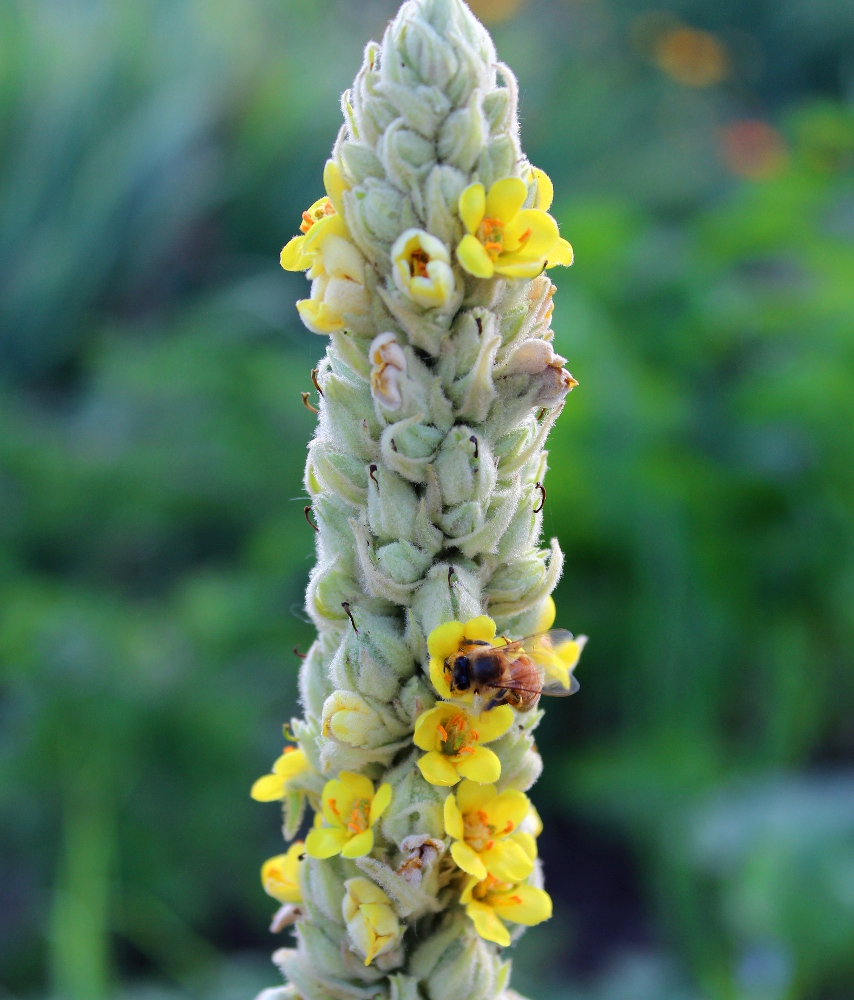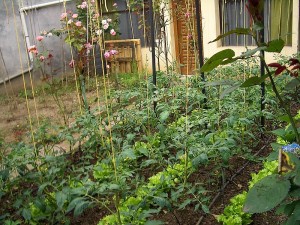(Honey bee on mullein flower, community garden, Portland, OR. Image by Lupa, 2014.)
Ever since I moved to Portland in 2007, I’ve spent every summer solstice at Sunfest, a local pagan festival west of Portland. I’ve collected many fond memories of the event, and last year I led the opening, closing, and main rituals, an incredible experience with an incredible group of people on beautiful land. This year, though, I opted to stay home, not because I don’t look forward to Sunfest, but because every so often it’s good to take a break, and I intend to go back next year refreshed and rejuvenated. (I heard people had a great time, there, too!)
So what did I do instead? Well, I’d been out of town the previous week, and while I was away it rained much of the time. This meant that upon my arrival back home, my community garden spot had a healthy crop of weeds popping up amid the more intentional plants. So a good bit of my weekend was spent with my hands in the dirt, digging up crabgrass and Russian thistles and a host of other unwanted invaders. I ended up with scraped fingers and sore shoulders, but by the time I was done things were looking a lot better (if not perfect).
I also took the time to plant out my little balcony container garden, which I admit I’ve been neglecting some as I’ve wrangled with the weeds down the street at the larger plot. But my herbs were all doing just fine, and the volunteer marigolds and petunias that sprouted from last year’s dropped seeds all ended up gathered together in one long planter box. Soil was freshened up, fluffed, and fertilized, and I planted out beans and arugula and other seeds. I also made my yearly pilgrimage to Fred Meyer’s clearance aisles in the garden section, where I brought home eight tomatoes and two unlabeled squash in sad condition which I’ll be attempting to resurrect with some TLC. Along with these I bought a very marked-down hanging pot of petunias; I thought the hummingbirds might like it.
 Still little. Still lovely. My balcony garden <3[/caption]Wait. Hummingbirds?
Okay. For those of you familiar with my work, you may have noticed that I've historically been against feeding wildlife, birds included. Putting out food where raccoons and possums can get it, for example, encourages them to be less afraid of humans and causes them to be more of a nuisance (we see this writ large in the black bears at Yellowstone). However, I was researching something on the Audubon Society website, and discovered that some of the things I had learned about feeding birds, to include the risk of interrupting migration and causing them to neglect natural food sources, were actually incorrect. I figure if the Audubon Society says it’s okay to feed birds, then there’s probably something to it. So I’ve had a bird feeder on the porch for the past couple of weeks and have entertained several scrub jays, crows, and house sparrows at it. (I figure two native species out of three isn’t bad, especially in this urban a setting.) It’s located where I can look right out at it while I’m working at my computer, and it’s been beneficial for both me and the birds. They get food with minimal effort and no threat of predation, and I get to watch their daily tiny-dinosaur dramas play out at the feeders (will the sparrows get a full meal before the scrub jays chase them off? Can the crows cope with the fierce competition for sunflower seeds?)
Still little. Still lovely. My balcony garden <3[/caption]Wait. Hummingbirds?
Okay. For those of you familiar with my work, you may have noticed that I've historically been against feeding wildlife, birds included. Putting out food where raccoons and possums can get it, for example, encourages them to be less afraid of humans and causes them to be more of a nuisance (we see this writ large in the black bears at Yellowstone). However, I was researching something on the Audubon Society website, and discovered that some of the things I had learned about feeding birds, to include the risk of interrupting migration and causing them to neglect natural food sources, were actually incorrect. I figure if the Audubon Society says it’s okay to feed birds, then there’s probably something to it. So I’ve had a bird feeder on the porch for the past couple of weeks and have entertained several scrub jays, crows, and house sparrows at it. (I figure two native species out of three isn’t bad, especially in this urban a setting.) It’s located where I can look right out at it while I’m working at my computer, and it’s been beneficial for both me and the birds. They get food with minimal effort and no threat of predation, and I get to watch their daily tiny-dinosaur dramas play out at the feeders (will the sparrows get a full meal before the scrub jays chase them off? Can the crows cope with the fierce competition for sunflower seeds?)
This, then, was my ritual. I haven’t formally celebrated the Sabbats in years, but if I were to call this summer solstice anything, it would be a harvest festival. I’d been picking beet greens all month for salads and pulled up and stored my spinach, which was threatening to bolt, just before I left town. But this weekend’s haul was even better–a nice big handful of bush peas, ten nice-sized (but not too big) red beets, and a bright bouquet of calendula for both eating and prettying up the apartment a bit. This is my first year really getting to use my garden, and I don’t think I could have envisioned how lovely the harvest would be back in February when I first sowed the seeds. (The beet roots roasted beautifully, by the way, and the leaves and the rest went into a glorious salad.)
All in all, it was a good time to renew my bond with the land through this direct contact. I try to spend at least a little time with my garden almost every day, but the timing worked out that a lot of effort needed to be put into it right now, and instead of being a chore all the weeding and harvesting and replanting was a celebration of gratitude. I’m grateful for my little gardens and the life they support, including my own. I’m grateful that I have the time and schedule flexibility to be able to devote to them. I’m grateful I can invest a bit of money in seeds, starts and other short-term needs in order to get a long-term payout. I’m grateful the weather has cooperated (mostly), and that my plants have survived spring hailstorms and hot days to thrive. Most importantly, I’m grateful for the lessons my gardens have taught me, not just about necessary care and potentials for change and growth, but about what draws me so near to the land here. We give to each other, and I vow once again to be a good caretaker of my tiny corner of the world.





